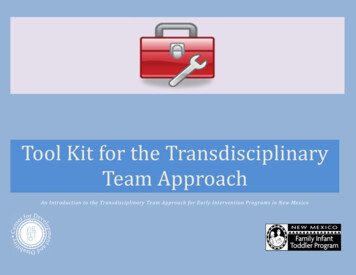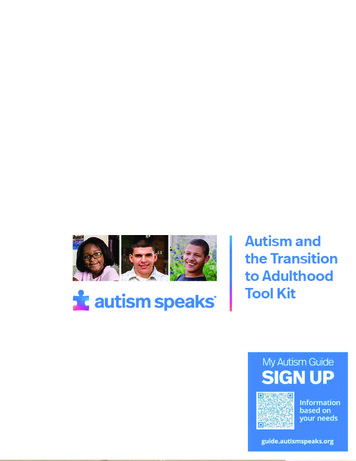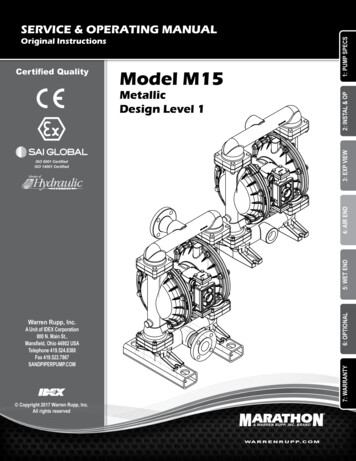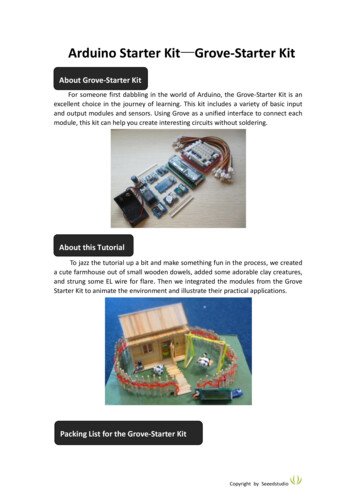
Transcription
Tool Kit for the TransdisciplinaryTeam ApproachAn Introduction to the Transdisciplinary Team Approach for Early Intervention Programs in New Mexico
Tool Kit for the Transdisciplinary Team ApproachHow to Use This Tool KitThe Transdisciplinary Team Approach (TTA) Tool Kit is a brief introduction to the Transdisciplinary Team Approach for EarlyIntervention (EI) agencies, and their partners, in New Mexico. It includes an overview of the process and key concepts, as well ashelpful information and resources to support and guide new early intervention staff and their partners in their understanding of theTransdisciplinary Team Approach. It is intended to be used as an orientation for new staff and not as a substitute for specifictraining. It is recommended that each individual agency provide ongoing training and support to all new staff regarding practices,systems, and processes as they relate to the Transdisciplinary Team Approach that are agency-specific.1
Tool Kit for the Transdisciplinary Team ApproachTable of ContentsIntroduction to the Transdisciplinary Team Approach . 3Key Elements of the Transdisciplinary Team Approach . 4Why Use the Transdisciplinary Team Approach to Early Intervention?. 5How is the Transdisciplinary Team Approach Different from Other models? . 6Transdisciplinary Approach vs. Traditional Approach . 7What Do Transdisciplinary Teams Look Like? .8‐9What Does the Transdisciplinary Team Approach Look Like for Families? . 10What is the Role of the Lead? . 11How is the Lead Selected?. 12New Mexico – Family Infant Toddler (FIT) Program Transdisciplinary Team Approach – Role Clarification . 13Critical Components for the Success of the Transdisciplinary Team Approach . 14Summary . 15References . 16Web‐based Resources to Support TTA Implementation. 172
Tool Kit for the Transdisciplinary Team ApproachIntroduction to the Transdisciplinary Team ApproachIDEA Part C Regulations §303.112 require that:“Each system must include a State policy that is in effect and that ensures that appropriate early intervention services are based onscientifically based research, to the extent practicable, and are available to all infants and toddlers with disabilities and their families.”The Transdisciplinary Team Approach (TTA) is founded on the New Mexico Family Infant Toddler (FIT) Program Key Principles forProviding Early Intervention Services in Natural Environments. These principles, developed by the Early Childhood TechnicalAssistance Center (ECTA, formerly NECTAC) reflect evidence-based practices in early intervention. The principles incorporate thecore values of FIT and have been adopted by the FIT System (see Appendix A). They can be applied to meet the unique needs offamilies and children served in New Mexico.Background:In 2011, the FIT Program conducted a pilot with 4 EI agencies to begin work toward implementing the Transdisciplinary TeamApproach and to provide feedback on the planning and implementation processesIn 2012 the FIT Program and the UNM Center for Development & Disability’s Early Childhood Learning Network (ECLN)partnered to roll out the Transdisciplinary Team Approach in two phases which included on site trainings at every EI agencystatewide:o Each agency identified a core team of staff who were trained to be the “in house experts” on the TTA.o Phase I of the TTA Approach (October, 2012 – March, 2013) included a self –assessment process to identify strengthsand challenges in implementing the TTA.o Phase II (April, 2013 – October, 2013) focused on reviewing the self-assessment results and developing animplementation plan.All agencies are expected to have the Transdisciplinary Team Approach fully implemented within one year of the completionof the Phase II visit.Definition: The Transdisciplinary Team Approach is a family-centered process for supporting families of young children withdisabilities or delays. In this approach, one member of an identified multidisciplinary team is selected as the lead interventionist andreceives coaching from other team members as needed. The lead, in turn, uses coaching as the key intervention strategy to build thecapacity of parents and other care providers in using everyday learning opportunities to encourage the development of theirchildren’s skills .3
Tool Kit for the Transdisciplinary Team ApproachRush & Shelden: Planning to Implement an Evidence- Based Practice Model in Early Childhood InterventionKey Elements of the Transdisciplinary Team ApproachThe team includes individuals from multiple disciplinesTeams meet on a regular basisThe team has a clear and common purposeTeam members cross discipline boundariesOne team member serves as the Lead for the familyParents are an integral part of the teamThe team works together by pooling knowledge, skills and resourcesCo-visits are encouragedServices are individualized for familiesAll members share responsibility for implementation of the IFSP4
Tool Kit for the Transdisciplinary Team ApproachWhy Use the Transdisciplinary Team Approach to Early Intervention?Current IDEA language encourages state Part C (EI) programs to examine not only where services are provided but how to serve familiesutilizing evidence –base practices in order to “enhance the capacity of families to meet the special needs of their infants and toddlerswith disabilities” (IDEA 631(a)(4)). Research shows that most families prefer to have one consistent person working with them overtime. Services are provided in the least intrusive manner, which includes being cognizant of the number of professionals providingservices to a family at one time. The use of a Transdisciplinary Team Approach is not intended to limit a family’s access to supports andservices, but, instead, to expand support for families by using teams of individuals representing multiple disciplines who are involvedwith and accountable to the family and to one another.In addition the Transdisciplinary Team Approach:Points intervention toward functional, integrated supports and servicesHelps avoid duplication and fragmentationBlends multiple perspectives and expertiseReduces the likelihood of conflicting and confusing reports and communications with familiesEnhances coordination of servicesIs less intrusive for familiesEvidence Based PracticesIs less confusing to parentsZERO TO THREE Journal (March 2011)Enhances skills of the practitioners on the teamarticle – “Current and emerging evidence(Carpenter, 2005; Davies, 2007) and (Eigsiti & Rapport, 2008)based practices – including routinesbased transdisciplinary models arebeing integrated into early interventionprograms throughout the country”.(Cole, Oser & Walsh)5
Tool Kit for the Transdisciplinary Team ApproachHow is the Transdisciplinary Team Approach Different from Other models?Multidisciplinary-In the multidisciplinary approach, professionals provide separate evaluations and assessments, set theirown discipline-specific goals for the child, and implement individual intervention plans. The team members maycommunicate with each other on a less frequent and less formal basis than with other models.Interdisciplinary-An interdisciplinary team requires interaction among the team members for the assessment anddevelopment of the intervention plan (IFSP- Individualized Family Service Plan). The team determines the best method forservice delivery that may include one or more providers.Transdisciplinary-Today, the most prevalent model is the transdisciplinary one. This model calls for one team member toprovide the interventions; to accomplish this other members must teach the service provider aspects of their discipline. Inother words, therapists and other service providers may teach others activities or intervention strategies that do notrequire the expertise of the therapist. It is important that the family and other team members understand that whenperforming the activities that a therapist has taught them, they are only doing activities, not providing therapy.Adapted from: Vanderhoff, Michelle. APTA Maximizing Your Role in Early Intervention. PT Magazine, 2004.6
Tool Kit for the Transdisciplinary Team ApproachTransdisciplinary Approach vs. Traditional ApproachTransdisciplinary ApproachVersusTraditional ApproachFamily-CenteredVersusProfessionally CenteredStrength-basedVersusDeficit-based modelsEmpowermentVersusExpertise modelsResource basedVersusService based modelsVersusRemediation of a disorder, problem,disease or its consequenceEnhancement and optimization ofcompetence and positive functioningProfessionals as agents of familiesand responsive to their desires andconcernsVersusProfessionals as experts whodetermine the needs of clients fromtheir own perspectives.Carl Dunst (2000) in “Rethinking Early Intervention” outlined the differences in implementing the transdisciplinary model.7
Tool Kit for the Transdisciplinary Team ApproachWhat Do Transdisciplinary Teams Look Like?Parents and Family Service Coordinators are always an integral part of the team. Other team members represent professionals fromvarious educational backgrounds including: special education/child development (Developmental Specialists –DS), social work,psychology, medical, and physical, occupational and speech/language therapy as well as professionals from other disciplines, statesupported schools (NMSBVI- New Mexico School for the Blind & Visually Impaired/NMSD – New Mexico School for the Deaf) and otheragencies. The individual that is designated as the Lead interventionist is selected based upon outcomes desired by the family,rapport/relationship between the Lead (coach) and the family (learner), knowledge of the Lead interventionist, and theschedule/availability of the Lead interventionist and family. This approach requires team members showing respect for each and awillingness to share professional expertise, in order to promote: Alignment of strategies Coordinated approach to service delivery Collaboration between team membersDefining TransdisciplinaryMembers of a transdisciplinary teamcross professional discipline boundariesto achieve service integration byconsulting with one another. They donot abandon their discipline, but blendspecific skills with other team membersto focus on and achieve integratedoutcomes (Pletcher & Younggren-inpress)8
Tool Kit for the Transdisciplinary Team ApproachWhat Do Transdisciplinary Teams Look Like?Philosophy ofTeam InteractionLines ofCommunicationIFSPDevelopmentIFSPImplementation Team Memberscommit toteach, learn,and work acrossdisciplinaryboundaries toplan andprovideintegratedservices Meets regularlyto shareinformation andto teach andlearn acrossdisciplines;consultationand teaming arefundamental Staff and familydevelop plantogether basedon functionalassessments.The family isvalued as anactive memberwith a decisionmaking role. One personworks mostoften with thefamily andother membersprovide supportthroughconsultationand co‐visits.9
Tool Kit for the Transdisciplinary Team ApproachWhat Does the Transdisciplinary Team Approach Look Like for Families?Services in a Transdisciplinary Team approach are individualized to meet the needs of each child and family. This is not a “one size fitsall” approach. The team determines how to best meet the outcomes on the IFSP. This will include a mix of direct services, co-visitsand/or consultation as appropriate. Frequency and intensity of services and supports are decided collaboratively based on the uniqueneeds of the child and family.Emilio & His FamilyBrianna & HerFamilyMonica & HerFamily 1x/wk visits withDS (lead) 1x/mo co‐visit DS& SLP 1x/qtr visit withnurse Team meets oncea month for 1hour 1x/wk visit withOT (lead) 2x/mo visit withDS (NMSD) 1x/qtr co‐visitwith OT &PT Team meets twicea month for 1/2hour 2x/mo visit withFamily Therapist(lead) 1x/mo visit withDS Team meets everyother month for 1hour10Arthur & His Family 1x/wk visit withPT (lead) 1x/day Early HeadStart (EHS)classroom teacher 1x/mo visit withDS 2x/DS & PT co‐visit at the EHScenter Team meets oncea month for 1hour
Tool Kit for the Transdisciplinary Team ApproachWhat is the Role of the Lead?The Lead, who is a direct service provider/interventionist, serves as the point-of-contact between the family and other teammembers. The Lead is designated on the IFSP and typically works most frequently with the family. He/She establishes a strongrelationship with the family. This relationship allows the family to develop a significant relationship with one provider who hasthe most knowledge and understanding of the family and who can share this information when collaborating with other teammembers.Effectiveness of Lead RolePreliminary survey data of a parent report of the helpfulness of early intervention providers indicate that96% of the parents having one provider rated him/her as helpful, 77% of the parents having two providersrated them as helpful, and 69% of parents having three or more providers rated them as helpful. (Dunst &Bruder, 2004 Findings from National Survey of Service Coordination in Early Intervention (Research andCoordination)11
Tool Kit for the Transdisciplinary Team ApproachLEADHow is the Lead Selected?The Lead interventionist is the member of the team who is determined the best possible matchfor a child and family. There are many possible ways to select a lead and an agency often has itsown process for selecting the lead. The following chart includes some valuable considerationsfor selecting a “Lead”:Family Factors Family priorities Family dynamics ScheduleChild Factors Diagnosis/Needs Primary location MotivatorsEnvironmental Factors Nature of dailysettings Safety DistanceProvider Factors Relationship withfamily Expertise AvailabilityAdapted from Rush & Shelden, Worksheet for Selecting the Most Likely Primary Service Provider. CASEtools, Vol. 6 (3), 2012.Note that any team member may be the “Lead” person, with the exception of the service coordinator in programs that use adedicated service coordinator model.12
Tool Kit for the Transdisciplinary Team ApproachNew Mexico – Family Infant Toddler (FIT) Program Transdisciplinary Team Approach – Role ClarificationFamily Service CoordinatorDual Role (FSC/DS)Lead (Direct Service Provider)(FSC) Each family has a Lead identified by the IFSP team.The Lead is designated on the IFSP.The Lead typically is the direct service providerworking most frequently with the family.The IFSP team (including the family) may change thedesignated Lead as needed.Ongoing Responsibilities:Keeps abreast of the changing circumstances, needs,interests, strengths and demands in the family’s lifewhich affect the ability to achieve the outcomes onthe IFSP.Ensures coordination of intervention efforts acrossdisciplines and collaboration among team members.Is the liaison between the family and the teamregarding interventionsPromotes co-visits.Works closely with FSC.Requests that FSC convene a full IFSP team meeting(with parents) if the team identifies a need for achange in services or frequency / intensity.Orients new team members regarding the effectiveimplementation of IFSP strategies and approacheswith the child and family.At consultation meetings:Facilitates and promotes discussion among teammembers to ensure alignment of strategies.Encourages discussion to identify recommendationsthat promote the integration of services.Fosters sharing and learning across disciplines. All families will continue to have adesignated FSC under theTransdisciplinary Team Approach, FSC is identified on the IFSP. Personnel in a dual role (i.e. FamilyService Coordinator ANDDevelopmental Specialist) can serveas the LeadOngoing Responsibilities: Responsible for providing all FamilyService Coordination activities as per FITregulations and service standards,regarding coordination of: intake;evaluation and eligibility determination;rights and procedural safeguards; theIFSP; coordination of services andtransition, etc. At the request of the Lead, the FSCarranges meetings with team membersto ensure opportunities for consultation.Ongoing Responsibilities: The person in a dual role who isalso designated as the Leadshould declare when he/she isfunctioning in each role (e.g. “Asthe team Lead, I will talk to theother team members and see ifthey have any thoughts regardinghow to encourage Ricky to begintrying solid foods ”).At consultation meetings: Participates in planned consultationmeetings with team members, as oftenas possible, to support planning effortsof the team. At the request of the Lead, facilitatesthe consultation meeting. Identifies items that need to beaddressed (e.g. referrals to otherresources, convening an IFSP teammeeting, communication withcommunity partners, etc.)13At consultation meetings: See correspondingresponsibilities under Lead andFSC. Documentation for billingpurposes will correspond to therole that is assumed during themeeting.
Tool Kit for the Transdisciplinary Team ApproachCritical Components for the Success of the Transdisciplinary Team ApproachRespect theparents as thefinal authorityon the goals fortheir child.Show strongcommitment toeducating eachotherListen to theparents andotherprofessionals onthe teamCommite icationopen14Work closelywith all teammembers to planassessments communicationamong all teammembers
Tool Kit for the Transdisciplinary Team ApproachSummaryAs research data on effective practices in early intervention indicates that families benefit most from a primary provider working withthe family while receiving team support, the NM FIT Program has chosen to adopt a Transdisciplinary Team Approach. This approachguides every interaction with every family and child involved with early intervention including:The family’s introduction to early intervention- during which the role of the family as team member and that of the serviceproviders is explained;The manner in which the initial evaluation and IFSP (Individualized Family Service Plan) meetings are conducted by a team;How services are provided by a team, with a designated person taking the “lead” in interactions with the family and childWith a cohesive team providing consistent communication and support to a family,parents’ dreams truly can be realized!15
Tool Kit for the Transdisciplinary Team ApproachReferencesPlanning to Implement an Evidence- Based Practice Model in Early Childhood Intervention; Power Point Presentation by M’LisaShelden and Dathan Rush; Family, Infant & Preschool Program & Orelena Hawks Puckett Institute Organton, North CarolinaTransdisciplinary Consultation: A Center-based Team Functioning Model; Education & Treatment of Children; May 1, 2000;Kaczmarek, Louise; Pennington, Ruth; Goldstein, HowardProviding Early Intervention Services in Natural Environments by Juliann Woods The ASHA Leader March 25, 2008The Transdisciplinary Team Approach Key Concepts: Power Point Presentation by Andy Gomm and Judy KimmelNew Mexico – Family Infant Toddler (FIT) Program Transdisciplinary Team Approach – Role Clarification; Andy GommAPTA: Maximizing Your Role in Early Intervention; PT Magazine, 2004; Vanderhoff, Michelle.Revisiting “Rethinking Early Intervention”; Topics in Special Education, Summer 2000, Vol. 20, no. 2, 95-104; Dunst, Carl.Worksheet for Selecting the Most Likely Primary Provider; CASEtools, Vol. 6 (3), 2012; Rush, Dathan; Shelden, M’Lisa.Building on the Foundations of Part C Legislation: Beginning the Conversation for Reauthorization; Zero to Three, Vol. 31 (4),2011; Cole, Patricia; Oser, Cindy; Walsh, Sharon.Early Intervention – IDEA Part C: Service Delivery Approaches & Practices by Lynda Cook Pletcher & Naomi Youngren in EarlyChildhood Intervention : Shaping the Future for Children with Special Needs and Their Families Vol. 2 / Christina Groark, seteditor; Santa Barbara, Calif. : Praeger, 201116
Tool Kit for the Transdisciplinary Team ApproachWeb‐based Resources to Support TTA ImplementationIndividual Family Staffing Report for Sharing Information and Planning During Team setool vol6 no1.pdfJoint Visit Planning Tool When Using a Primary Service Provider Approach to setool vol6 no2.pdfWorksheet for Selecting the Most Likely Primary Service l vol6 no3.pdf17
The team includes individuals from multiple disciplines Teams meet on a regular basis The team has a clear and common purpose Team members cross discipline boundaries One team member serves as the Lead for the family Parents are an integral part of the team The team










